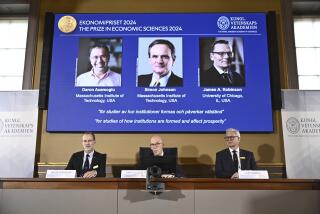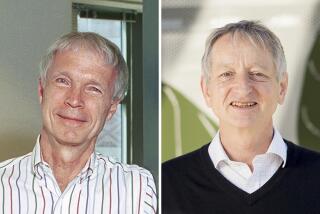Caltech Scientist Wins the Nobel Chemistry Prize
A Caltech professor won the 1992 Nobel Prize in chemistry on Wednesday for theories that help explain how living things store energy, but first word of the $1.2-million award went to his answering machine.
Rudolph A. Marcus was at a conference when Nobel committee officials left a message at his Pasadena home. A colleague who lives down the street said he got the next telephone call, a 6 a.m. wake-up notice that “you didn’t win, but your friend Rudy Marcus did” along with an urgent inquiry as to the winner’s whereabouts. It took 15 minutes to track Marcus to a downtown Toronto hotel.
The Royal Swedish Academy of Sciences in Stockholm also announced the awarding of the physics prize to Georges Charpak of France for his 1968 invention of a subatomic particle detector that reveals “the secrets of the inner parts of matter.” Charpak’s detector was the forerunner of many others used in “practically every experiment in particle physics” today, the academy wrote.
Marcus said at a hastily called press conference that while many people might consider winning the Nobel Prize “the ultimate” achievement, he thinks the biggest triumph “is being able to solve problems and seeing your work used. . . . I don’t know that I want to attract more attention to my work. I just want more time to get it done.”
A native of Canada who is now an American citizen, Marcus, 69, began formulating his theory in 1952 as he puzzled over a graduate student’s question. He first published his conclusions in 1956 and continued to refine them over the next nine years. His ideas were controversial until they were confirmed by experiments over three decades.
He won the prestigious Wolf Prize, awarded by an Israeli foundation, in 1985. The next year, the Journal of Physical Chemistry devoted a special issue to the 30th anniversary of the Marcus Theory.
“His theories had an enormous impact,” said Harry Gray, the Caltech chemist who got the news first from Sweden. “This is a very well-deserved prize. I don’t think it will be a surprise to anyone in chemistry.”
The work provides a mathematical way to determine how fast or slow, or in what direction, electrons jump between molecules without breaking chemical bonds.
These electron transfers are what make it possible for plants to store energy from sunlight and use it later to fuel growth--and for people to store energy from a meal and use it later to help power the body’s activities.
Marcus “made the theoretical link between electron transfers and energy,” said John R. Miller, a chemist at Argonne National Laboratory who was involved in experiments in the mid-1980s that bolstered a portion of the theory. Miller said it is energy, whether it is in sunshine, buttered toast or some other form, that prompts an electron to “jump” from one molecule to another. And the path and speed of the jumps determine how efficiently the energy is held in reserve.
The understanding of these processes can have a wide variety of applications, from photocopying to the creation of synthetic chemicals to solar energy. Electron transfers are also involved in rust.
At the press conference at Toronto’s Royal York Hotel--where Marcus had just delivered the lead paper for the 182nd meeting of the Electrochemical Society Inc.--the prizewinner said he would be pleased if his research helps society reduce dependence on fossil fuels. “There’s lots of sunlight up there,” he said. “Anything that has to do with sunlight has to have something going for it.”
Caltech faculty members and alumni have now won 22 Nobel Prizes in chemistry, physics, physiology or medicine and advancement of world peace. The chemistry department gathered in a courtyard on the Pasadena campus Wednesday afternoon to toast Marcus’ triumph, despite his absence.
The professor was lauded for his enthusiasm for theoretical chemistry. His research assistant, Hui Ou Yang, said Marcus telephoned him last Christmas Eve from Arizona to talk about a new insight and called Tuesday from an airport on the way to Toronto for a similar discussion. “He just needs a pencil and a piece of paper,” Hui said. “And his brain.”
Charpak, the physics prizewinner, was born in Poland and now is a citizen of France. He works at CERN, the European particle physics laboratory on the Swiss-French border at Geneva. He also serves as a professor at the School of Advanced Studies in Physics and Chemistry in Paris.
The 68-year-old physicist conceived of an instrument to study subatomic particles thousands of times faster and much more precisely than in the past.
The largest of the cylindrical detectors is about nine yards long and about two yards in diameter. It is filled with gas in a magnetic field and with as many as 100,000 wires strung parallel to each other to form concentric cylinders.
Charged particles created in various reactions then produce electrons, which are drawn to the wires.
“You can tell how far away from the wire these electrons are produced by how long it took them” to arrive there, said Albert Silverman, emeritus professor of physics at Cornell University. The various positions can be used to determine the path and momentum of the electrons, allowing physicists to deduce many of the qualities of the original particles.
CERN colleague Jean-Marc Gaillard said Charpak “is now spending all his time and energy and, to some extent, his money in applying his work to biology and medicine.”
In a telephone interview, Charpak said he hopes he can use the detector in medicine to produce better drugs. For example, the instrument could trace radioactively labeled molecules through the human body more quickly and accurately than is currently possible. “You may want to know receptor sites in the brain for pharmaceutical research,” he said. “At a hospital in Geneva we are doing in one day what it took three months to do with other methods.”
Charpak said of the award, “It was a very great pleasure and a surprise. . . . I had a very hard week of work and I didn’t expect it at all.”
He was a member of an international coalition of scientists who offered in 1984 to trade places with Yelena Bonner, wife of physicist and dissident Andrei Sakharov, if Soviet officials would let her go abroad for medical treatment. Sakharov was reportedly on a hunger strike at the time.
Pasternak reported from Los Angeles and Walsh from Toronto. Times staff writer Edmund Newton also contributed to this story.
Caltech’s Nobel Laureates
Caltech faculty and alumni have won 22 Nobel prizes.
NAME FIELD YEAR Robert A. Millikan* Physics 1923 Thomas Hunt Morgan* Physiology or Medicine 1933 Carl D. Anderson* Physics 1936 Edwin M. McMillan Chemistry 1951 Linus Pauling* Chemistry 1954 William Shockley Physics 1956 George W. Beadle* Physiology or Medicine 1958 Donald A. Glaser Physics 1960 Rudolf Mossbauer* Physics 1961 Linus Pauling* Peace 1962 Charles H. Townes Physics 1964 Richard Feynman* Physics 1965 Murray Gell-Mann** Physics 1969 Max Delbruck* Physiology or Medicine 1969 Leo James Rainwater Physics 1975 Howard M. Temin Physiology or Medicine 1975 William N. Lipscomb Chemistry 1976 Robert W. Wilson Physics 1978 Roger W. Sperry** Physiology or Medicine 1981 Kenneth G. Wilson Physics 1982 William A. Fowler** Physics 1983 Rudolph A. Marcus** Chemistry 1992
* Indicates faculty members at the time they received the prizes.
** Still in residence.






